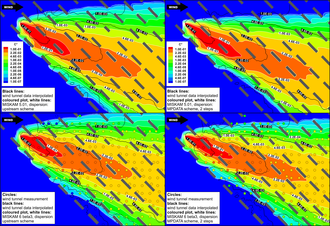Development and application of the model MISCAM
Development of MISCAM startet in the 1980s at the Institute for Atmospheric Physics within the framework of two projects funded by the German Ministry of Education and Research.
As suggested by environmental agencies and consultant, the model was ported from a mainframe to personal computers. Since then, MISCAM established itself as a useful tool for consultants, leading to more than a hundred implementations in Germany. Additional user interfaces have been developed by external companies.
MISCAM consists of a three-dimensional non-hydrostatic flow model, a two-equation turbulence model and an Eulerian transport model.
The flow model has been successfully validated according to the VDI Guideline 3873/9 "Prognostic microscale wind field models - Evaluation for flow around buildings and obstacles". Latest evaluations have been carried out for the 64bit version 6.4 of MISCAM, including simulations for a complex building configuration.
Applications
Studies that have been carried out at IPA include
- Consequences of an enlargement of the university campus
- Effects of additional business buildings at the western boundary of the city of Mainz
- Transport of exhaust gases of chemical laboratories
- Odors in the vicinity of a sewage plant
- Small scale flow conditions in the surroundigs of holographic measurments
- Dry deposition of dust on historical facades
The figures show results of a validation study where MISCAM was applied to the Mock Urban Settings Test (MUST). The setting consisted of an array of shipping containers which had been rebuilt in a wind tunnel.


Publications (* peer reviewed)
- * Auras, M., Beer, S., Bundschuh, P., Eichhorn, J., Mach, M., Scheuvens, D., Schorling, M., von Schumann, J., Snethlage, R., Weinbruch, S.; 2013: Traffic-related immissions and their impact on historic buildings: implications from a pilot study at two German cities. Environmental Earth Sciences, doi: 10.1007/s12665-013-2276-4
- Eichhorn, J., von Schumann, J.; 2011: Numerische Modellierung der Ausbreitung und Deposition von Kfz-Emissionen. In: Wirkung verkehrsbedingter Immissionen auf Baudenkmäler - Eine Pilotstudie zu den Innenstädten von Mainz und München. IFS-Berichte, 37, ISSN 0945-4748, 79-86.
- * Belalcazar, L.C., Clappier, A., Blond, N., Flassak, T., Eichhorn, J.; 2010: A critical evaluation to the estimation of road traffic emission factors from tracer studies. Atmosph. Environ., 44/31, 3814-3822.
- * Eichhorn, J., Kniffka, A.; 2010: The Numerical Flow Model MISKAM: State of Development and Evaluation of the Basic Version. Meteorol. Zeitschrift, 19/1, 81-90.
- Balczó, M., Eichhorn, J.; 2009: Refined MISKAM simulations of the Mock Urban Setting Test. Proceedings of the XXIII. MicroCAD International Scientific Conference, Miskolc / Hungary, pp. 7-12; ISBN 978-963-661-866-7.
- Czáder, K., Balczó, M., Eichhorn, J.; 2009: Modelling of flow and dispersion in a street canyon by means of numerical simulation. Proceedings of the XXIII. MicroCAD International Scientific Conference, Miskolc / Hungary, pp. 47-52; ISBN 978-963-661-866-7.
- * Ries, K., Eichhorn, J.; 2001: Simulation of effects of vegetation on the dispersion of pollutants in street canyons, Meteorol. Zeitschrift, 10/4, 229 - 233.
- Eichhorn, J., Ries, R.; 1997: Einsatzmöglichkeiten numerischer Modelle zur Simulation der Geruchsstoffausbreitung, KTBL-Veröffentlichungen.
- Eichhorn, J.; 1996: Validation of a microscale pollution dispersal model, In: Air pollution modeling and its application XI, 539-545. Plenum Press, New York, 708pp.
- Eichhorn, J., Jaeschke, R., Ries, R., Beltz, N., Heil, O.; 1995: Naturmessungen verkehrsbedingter Immissionen als Grundlage zur Validierung des mikroskaligen Ausbreitungsmodells MISKAM, VDI-Berichte 1228, 473 - 494.
- * Eichhorn, J., Schrodin, R., Zdunkowski, W.; 1988: Three-Dimensional Numerical Simulations of the Urban Climate, Beitr. Phys. Atmosph., 61, 187 - 203.
PhD thesis
- Eichhorn, Joachim; 1989: Entwicklung und Anwendung eines dreidimensionalen mikroskaligen Stadtklimamodells
Diploma theses
- von Schumann, Jonas (2012): Simulation trockener Deposition in einem mikroskaligen Modell der Atmosphäre
- Kniffka, Anke (2002): Implementierung eines diffusionsarmen Advektionsschemas in das numerische Modell MISKAM
- Ries, Kai Uwe (2001): Numerische Simulation der Vegetationseinflüsse auf Strömungs- und Ausbreitungsvorgänge
- Itzstein, Martina (1997): Verifikation des Stadtklima-Modells MISKAM anhand lufthygienischer Meßdaten
- von Kuhlmann, Rolf (1997): Parametrisierung fahrzeuginduzierter Effekte im Stadtklimamodell MISKAM
- Früh, Barbara (1996): Untersuchungen zum Nesting meso- und mikroskaliger Strömungsmodelle
- Külzer, Stefan (1994): Erweiterung des dreidimensionalen Stadtklimamodells MISKAM auf Unterströmungseffekte
- Döring, Torsten (1993): Vergleich verschiedener Advektionsverfahren und Sensitivitätsstudien im urbanen Bereich